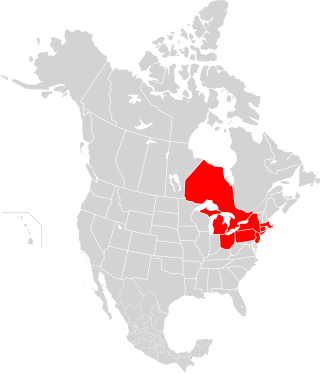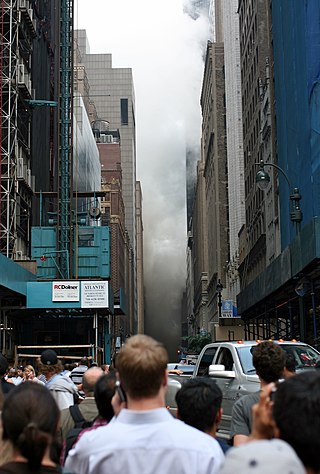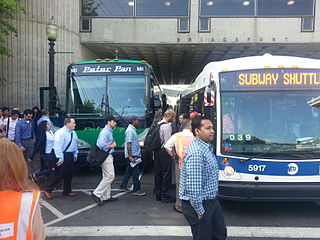
The northeast blackout of 1965 was a significant disruption in the supply of electricity on Tuesday, November 9, 1965, affecting parts of Ontario in Canada and Connecticut, Delaware, Maryland, Massachusetts, New Hampshire, New Jersey, New York, Pennsylvania, Rhode Island, and Vermont in the United States. Over 30 million people and 80,000 square miles (207,000 km2), and a population density of 144.9 inhabitants/km2 were left without electricity for up to 13 hours.
The 2003 London blackout was a serious power outage that affected parts of south London and north-west Kent in the evening of 28 August 2003. It was caused by a series of faults at National Grid transmission substations, which supplied the distribution network operator in the area, EDF Energy.
The New York City blackout of 1977 was an electricity blackout that affected most of New York City on July 13–14, 1977. The only unaffected neighborhoods in the city were in southern Queens, which were part of the Long Island Lighting Company system, as well as the Pratt Institute campus in Brooklyn, and a few other large apartment and commercial complexes that operated their own power generators.

Consolidated Edison, Inc., commonly known as Con Edison or ConEd, is one of the largest investor-owned energy companies in the United States, with approximately $12 billion in annual revenues as of 2017, and over $62 billion in assets. The company provides a wide range of energy-related products and services to its customers through its subsidiaries:
The 2006 Auckland Blackout was a major electrical blackout in Auckland, the largest city in New Zealand, on 12 June 2006. It started at 08:30 local time, with most areas of Auckland regaining power by 14:45 local time. It affected some 230,000 customers and at least 700,000 people in and around the city.

The Northeast blackout of 2003 was a widespread power outage throughout parts of the Northeastern and Midwestern United States, and most parts of the Canadian province of Ontario on Thursday, August 14, 2003, beginning just after 4:10 p.m. EDT.

On July 18, 2007, an explosion in Manhattan, New York City, sent a geyser of hot steam up from beneath a busy intersection, with a 40-story-high shower of mud and flying debris raining down on the crowded streets of Midtown Manhattan. It was caused by the failure of an 83-year-old, 24-inch (0.61 m) underground steam pipe near Grand Central Terminal, which exploded during the evening rush hour. 45 people were injured, and one woman died of a heart attack while fleeing.

The New York City steam system includes Con Edison's Steam Operations, which provides steam to large parts of Manhattan. Other smaller systems provide steam to New York University and Columbia University, and many individual buildings in New York City also have their own steam systems. The steam is used to heat and cool buildings and for cleaning and disinfecting. It is the largest such system in the world and has been in operation since 1882.
The 1996 Western North America blackouts were two widespread power outages that occurred across Western Canada, the Western United States, and Northwest Mexico on July 2 and August 10, 1996. They were spread 6 weeks apart and were thought to be similarly caused by excess demand during a hot summer.

Ravenswood Generating Station is a 2,480 megawatt power plant in Long Island City in Queens, New York City, owned and operated by LS Power/Helix Energy Solutions Group. The plant is fueled primarily by fuel oil and natural gas which heats the boilers.

The 2011 Southwest blackout, also known as the Great Blackout of 2011, was a widespread power outage that affected the San Diego–Tijuana area, southern Orange County, Imperial Valley, Mexicali Valley, Coachella Valley, and parts of Arizona. It occurred on Thursday, September 8, 2011, beginning at about 3:38pm PDT, and was the largest power failure in California history.
Several major power outages have occurred in the country of Malaysia.

Two severe power outages affected most of northern and eastern India on 30 and 31 July 2012. The 30 July 2012 blackout affected over 400 million people and lasted about 13.5 hrs. During that period, it was the largest power outage in history by number of people affected, beating the January 2001 blackout in Northern India. Similar conditions caused a blackout on the next day, which remained the largest power outage in history as of June 2024. The outage affected more than 620 million people, spread across 22 states in Northern, Eastern, and Northeast India. An estimated 32 gigawatts of generating capacity was taken offline. Of the affected population, 320 million initially had power, while the rest lacked direct access. Electric service was restored in the affected locations between 31 July and 1 August 2012.

New York was severely affected by Hurricane Sandy on October 29–30, 2012, particularly New York City, its suburbs, and Long Island. Sandy's impacts included the flooding of the New York City Subway system, of many suburban communities, and of all road tunnels entering Manhattan except the Lincoln Tunnel. The New York Stock Exchange closed for two consecutive days. Numerous homes and businesses were destroyed by fire, including over 100 homes in Breezy Point, Queens. Large parts of the city and surrounding areas lost electricity for several days. Several thousand people in midtown Manhattan were evacuated for six days due to a crane collapse at Extell's One57. Bellevue Hospital Center and a few other large hospitals were closed and evacuated. Flooding at 140 West Street and another exchange disrupted voice and data communication in lower Manhattan.

The September 2013 New Haven Line power outage was an unplanned electrical power outage that impacted service on Metro-North Railroad's New Haven Line for twelve days in 2013. On September 25, 2013, a 138-kV main feeder cable from Con Edison that provided electricity to an AC catenary-powered 8-mile (13 km) segment of the New Haven Line failed, causing electric train service over the line to halt between Mount Vernon, New York and Harrison, New York.
The Astoria Borealis was an industrial accident that occurred at a Con Edison substation in Astoria, Queens, New York City, on December 27, 2018. During the incident, a 138,000 volt coupling capacitor potential device failed, resulting in an arc flash, which in turn burned aluminum, lighting up the sky with a blue-green spectacle visible for miles around and as far as New Jersey. It received the humorous name "Astoria Borealis" due to its resemblance to the northern lights. The event was covered extensively on social media, and LaGuardia Airport temporarily lost power, but there were neither deaths nor injuries. Such was the magnitude of the bizarre illumination that extraterrestrial visitation was a common supposition.

The 2019 Argentina, Paraguay and Uruguay blackout was a massive power outage that struck most of Argentina, all of Uruguay, and parts of Paraguay on 16 June 2019, leaving an estimated 48 million people without electrical supply.

The West Side of Manhattan in New York City experienced a power failure on July 13, 2019, at approximately 7 p.m. EDT. Con Edison is the energy utility serving the area, and they reported that approximately 73,000 customers were without power. Power was fully restored by midnight. The power failure occurred on the 42nd anniversary of the New York City blackout of 1977, which left nine million customers without power.
The 2019 California power shutoffs, known as public safety power shutoff (PSPS) events, were massive preemptive power shutoffs that occurred in approximately 30 counties in Northern California and several areas in Southern California from October 9 to November 1, 2019, and on November 20, 2019, by Pacific Gas and Electric Company (PG&E), Southern California Edison (SCE), and San Diego Gas & Electric (SDG&E).












